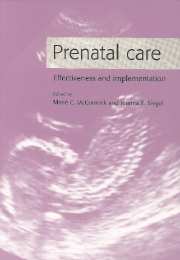Book contents
- Frontmatter
- Contents
- List of contributors
- Foreword
- Acknowledgments
- Introduction
- Part I Prenatal Care and Complications of Pregnancy
- Part II Preventing Prematurity
- Part III New Findings and Long-term Evidence on Intrauterine Growth Restriction
- Part IV Preventing and Treating Birth Defects
- Part V Prenatal Care as an Integral Component of Women's Health Care
- 12 Opportunities for improving maternal and infant health through prenatal oral health care
- 13 Family planning: need and opportunities
- 14 Maternal–fetal conflict is not a useful construct
- 15 Linking prenatal care with women's health care
- 16 A European perspective on prenatal care: an integrated system
- Epilogue
- Index
13 - Family planning: need and opportunities
Published online by Cambridge University Press: 17 August 2009
- Frontmatter
- Contents
- List of contributors
- Foreword
- Acknowledgments
- Introduction
- Part I Prenatal Care and Complications of Pregnancy
- Part II Preventing Prematurity
- Part III New Findings and Long-term Evidence on Intrauterine Growth Restriction
- Part IV Preventing and Treating Birth Defects
- Part V Prenatal Care as an Integral Component of Women's Health Care
- 12 Opportunities for improving maternal and infant health through prenatal oral health care
- 13 Family planning: need and opportunities
- 14 Maternal–fetal conflict is not a useful construct
- 15 Linking prenatal care with women's health care
- 16 A European perspective on prenatal care: an integrated system
- Epilogue
- Index
Summary
Introduction
The idea that prenatal care should have objectives beyond the birth of a healthy infant to a healthy mother is not a new one. In recent years, the most forceful expression of an expanded purpose for prenatal care can be found in Caring for Our Future, the 1989 report of the Public Health Service's Expert Panel on the Content of Prenatal Care (PHS, 1989). The report stated:
The prenatal period provides an opportunity to look beyond pregnancy and delivery to identify the resources essential for further healthy development of parents and infant. The objectives of prenatal care are concerned with more than the prevention of maternal and neonatal morbidity and mortality; these objectives include other aspects of the woman's health prior to, during, and after pregnancy and include the promotion of healthy child development, positive family relationships, and family planning (p. 2).
The book that followed this report, New Perspectives on Prenatal Care, amplified this view, noting that the preconceptional period, the nine months of pregnancy, and the postpartum visit or visits provide a “window of opportunity” to do more than ensure the delivery of a healthy infant (Klerman, 1990). Thus, the Public Health Service panel anticipated the ideas presented in this book, namely that during the prenatal period many women have an intense relationship with one or more providers of care.
- Type
- Chapter
- Information
- Prenatal CareEffectiveness and Implementation, pp. 271 - 284Publisher: Cambridge University PressPrint publication year: 1999



